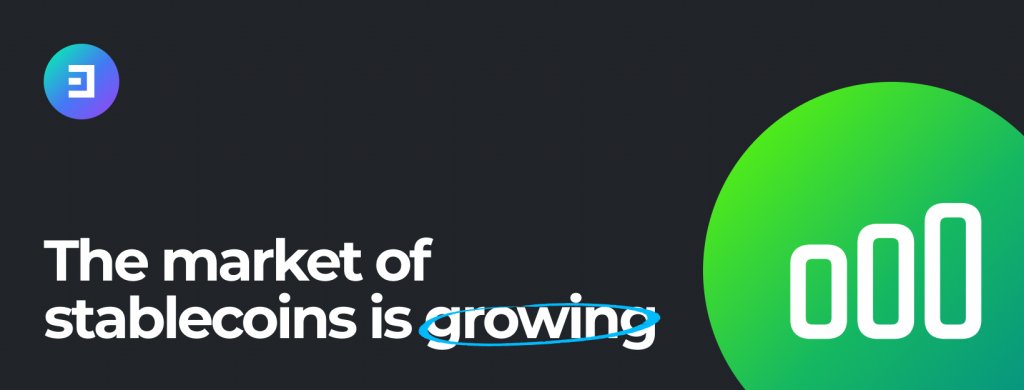The Rise of Algorithmic Stablecoins
According to Coinmarketrate.com stablecoins are varieties of cryptocurrencies that are backed by other assets, for example, US dollars, which allows them to be converted into national currencies at a guaranteed rate. But there are other stablecoins, algorithmic ones.
Algorithmic stable coins react to market events with the help of automatic stabilization measures. This increases their decentralization and opens up the possibility of creating a smart, responsive currency that is not controlled by one institution, and can serve as a medium of exchange in various industries.
Stable coins based on algorithms, unlike their centralized counterparts, do not have collateral, so they are also called unsecured stable coins. Algorithmic stablecoins are a new type of cryptocurrency created to increase price stability without the participation of a central authority. This is often done by pre-programming the supply in accordance with the demand for the asset.
The algorithm or protocol underlying these stable coins acts as a “central bank”. This helps to increase the supply in case of a deflationary trend in the token, or reduce the supply in case of a decrease in purchasing power. The rules for such actions of the algorithm are available in smart contracts in the embedded form. Changing the rules is only possible in decentralized stable coins through public consensus or management voting.
MakerDAO DAI Tokens
MakerDAO, the first protocol for issuing algorithmic stablecoin, was founded in 2015. This is a stable product with redundant collateral, which is located on the Ethereum blockchain.
MakerDAO was born as a result of the realization that early cryptocurrencies were unstable, and therefore were not particularly useful as a medium of exchange. Initially, the development of the project was led by the Maker Foundation, but now it is controlled by a decentralized autonomous organization (DAO).
The market capitalization of the DAI stablecoin.
The protocol was officially launched in 2017 as the Single Collateral DAI System (also known as SAI), which allowed users to mine DAI with Ethereum (ETH) as collateral. If the price of the deposit falls below a certain threshold, the position is automatically liquidated.
After the successful launch of the Single Collateral DAI system, in 2019, Maker introduced the Multi Collateral DAI (MCD) system, which allowed expanding the variety of types of software. With a market value of $9 billion, it has been the most popular algorithmic stablecoin for a long time.
The emerging UST competitor
Currently, the LUNA token is among the 10 largest cryptocurrencies by market capitalization, and the associated Terra platform is used to issue a stable TerraUSD (UST) coin.
Terra was built on the basis of the Cosmos SDK, and uses a delegated proof-of-stake consensus. Users wishing to mine UST must burn an equivalent amount of LUNA in US dollars. A small part of the LUNA tokens used for mining stable coins (also known as seigniorage) goes to the treasury, which makes mining stable coins a profitable business for the network. This process is similar to central banks making a profit when they print money.
UST Market Capitalization
The LUNA token is important for the ecosystem’s collateral mechanism, which ensures the stability of UST prices. For this reason, LUNA is designed in such a way as to have a dynamic offer that fluctuates according to the protocol assurance algorithm. The name of the protocol is an analogy of the symbiotic relationship between the Earth and the Moon and how these two celestial bodies provide each other with gravitational stability.
Magic Internet Money (MIM)
Abracadabra.Money is a platform that works by using interest-bearing assets to mine its own MIM asset. The purpose of the protocol is to create an exclusive way for users to obtain DeFi capital for effective management.
The protocol provides users with easy access to loans and allows them to raise money using leverage.
Market capitalization of the MIM token
Abracadabra is a credit pool for interest-bearing tokens. Therefore, it allows its users to effectively control the collateral rates, compared to traditional lending exchanges. First, the deposit is deposited on the Abracadabra platform, then the borrower is allocated the amount of debt and interest. After that, MIM tokens are sent to users’ wallets.
Like Terra, Abracadabra has two tokens: Magic Internet Money, a cryptocurrency tied to the US dollar, and SPELL, a management token and protocol utility used to stimulate and distribute rewards.
The first combination of the pledge mechanism and the algorithm
Assuming full collateral, and then reducing or increasing the collateral ratio, Frax Finance balances the market forces for the corresponding collateral.
This is the first and currently the only stablecoin in which part of the offer is secured by collateral, and part is algorithmically. This means that FRAX is the first stablecoin in which part of the offer is floating or unsecured.
FRAX Market Capitalization
Frax Shares (FXS) is a management token that accumulates commissions, seigniorage income and excess collateral value.
The ultimate goal of Frax is to create the first crypto version of the consumer price Index (CPI) – the Frax Price Index (FPI), managed by holders of FXS (and other protocol tokens).
Currently, FRAX is pegged to the US dollar, but aims to become the first decentralized, permission-free native unit of account that maintains a stable standard of living in accordance with CPI measurements.
